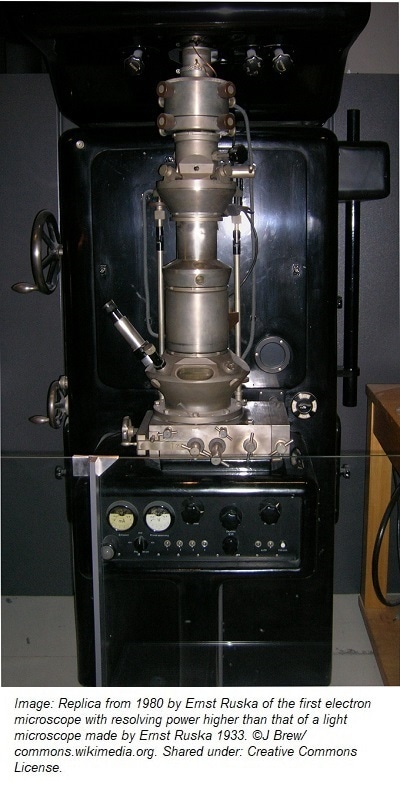The history of the electron microscope dates back to early twentieth century when the first electromagnetic lens was developed. This opened the door of possibility to use the principles of the lens to invent a microscope that could examine the structure of samples with greater detail. This had the potential to exceed the capabilities of the optical microscope, which was the first type of microscope and only alternative option at the time.
The term microscope is derived from the Greek works mikros and skopeo, which mean small and look at, respectively. Throughout the history of science, there has been a lasting interest in viewing the intricate details of the world in increasing magnifications.
For example, in biology, this allows us to examine the appearance and structure or cells, bacteria, viruses, and other particles. In geology, this allows us to view complex details of rocks, minerals, and fossils, which can provide insight into the history and future of the planet where we live.
Timeline of the electron microscope history
 Hans Busch invented the first electromagnetic lens in 1926 and, although he allegedly filed a patent for an electron microscope in 1928, he did not construct the microscope.
Hans Busch invented the first electromagnetic lens in 1926 and, although he allegedly filed a patent for an electron microscope in 1928, he did not construct the microscope.
It was Ernst Ruska and Max Knoll, a physicist and an electrical engineer, respectively, from the University of Berlin, who created the first electron microscope in 1931. This prototype was able to produce a magnification of four-hundred-power and was the first device to show what was possible with electron microscopy.
In the same year, Reinhold Rudenberg, who was the scientific director of Siemens-Schuckertwerke acquired the electron microscope patent.
In 1933, Ernst Ruska developed on the original model further to develop an electron microscope that was capable of producing an image of higher resolution than what was possible with optical microscopy. In 1937, Bodo von Borries and Helmut Ruska joined him to develop ways that the principles could be applied, such as to examine biological samples. In the same year, Manfred von Ardenne developed the first scanning electron microscope.
Siemens-Schuckertwerke released the first commercial electron microscope to the public in 1938. From this point onwards, transmission electron microscopes became more readily available in other areas of the world, including North America.
In 1986, Ernst Ruska was awarded the Nobel Prize in Physics for the invention of the electron microscope, in conjunction with Heinrich Rohrer and Gerd Binnig for the development of the scanning tunneling microscope (STM)
The present and future
Transmission electron microscopes are now commonly used in scientific research to examine samples at a higher resolution and increase our understanding of the world around us.
It is evident that the modern transmission electron microscopes are now capable of producing images of significantly higher magnification and resolution than the original models. However, the principles of the electron microscope are still based on the first prototype that was developed by Ernst Ruska.
Electron microscopes have surpassed many of the limitations of optical microscopes, with improved resolution that makes it possible to view microscopic objects such as atoms. However, enhancements to the electron microscope continue to be made to this day. For example, an environmental-scanning electron microscope that maintains a low vacuum in the sample chamber to view specimen with moisture is currently under development.
References
- https://www.thoughtco.com/history-of-the-microscope-1992146
- http://authors.library.caltech.edu/5456/1/hrst.mit.edu/hrs/materials/public/ElectronMicroscope/EM_HistOverview.htm
- https://www.fei.com/introduction-to-electron-microscopy/history/
- http://www.newworldencyclopedia.org/entry/Electron_microscope
- http://www.keyence.com/ss/products/microscope/bz-x700/study/history/003/index.jsp
- https://www.jstor.org/stable/4605737